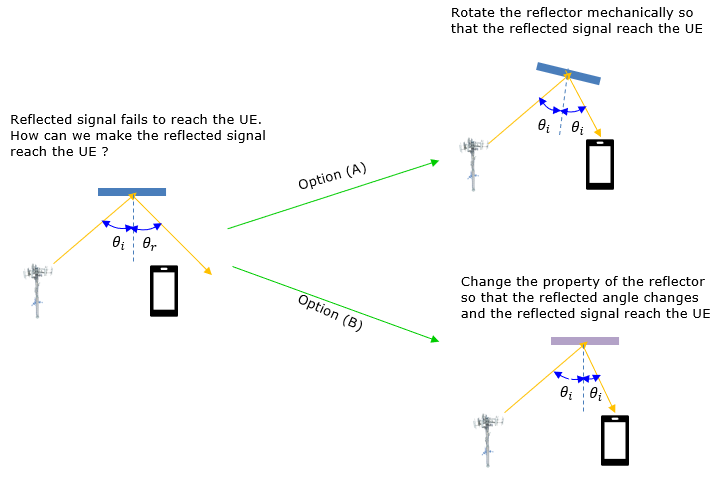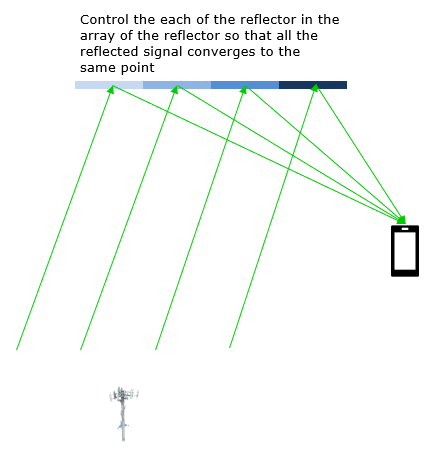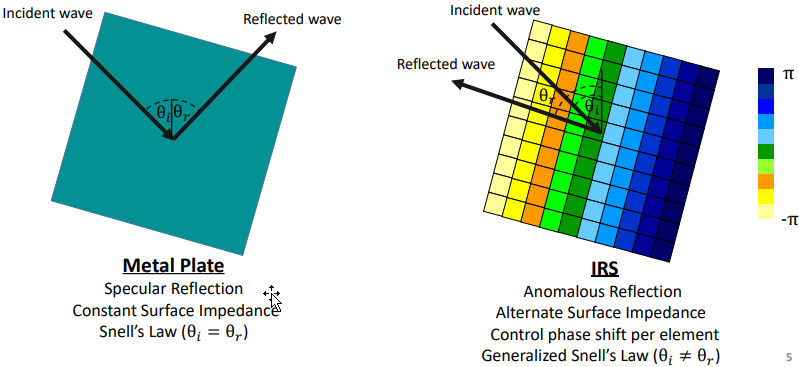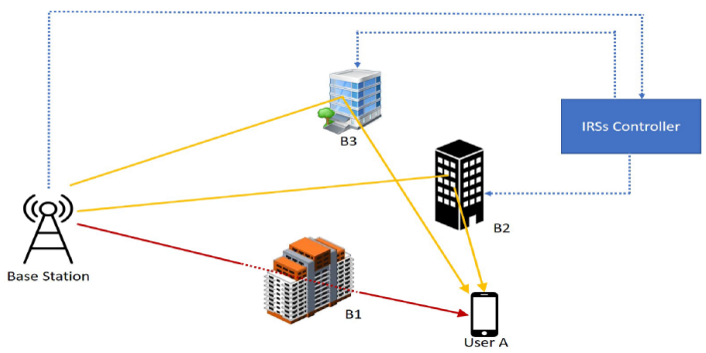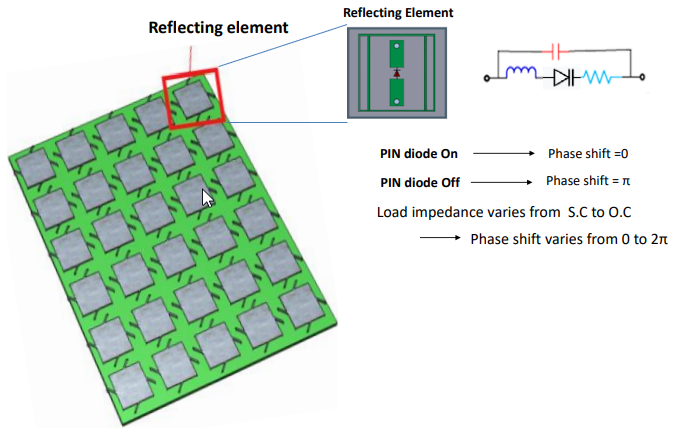|
RF |
||
|
Intelligent Reflective Surface (IRS) / Reflective Intelligent Surce(RIS)
Literally speaking, Intelligent Reflective Surface is a kind of reflective surface with intelligence. Obviously, a reflective surface is a surface which reflect a wave to another direction. The point here is the term 'intelligence', What does it mean by 'intelligent' in this context. Let me try explain on this with a simple example as illustrated below. Take a look at a situation shown on the left. A radio wave emitted from a tower gets reflected as indicated by the arrows. As shown here, the reflected wave does not reach to the UE in this setup and reflected angle. If I want the reflected wave to hit the UE, what should I do ? We may think of two options as labelled as Option (A) and Option (B) as below. The option (A) would be the one that everybody can think of. We may rotate the reflector mechanically so that the reflected wave reach the UE. Sound simple. But this does not sound 'intelligent'. If there is another way to change the direction of the reflected wave to arbitrary direction without mechanically rotating the surface. It can be called as 'intelligent' and this technology have been implemented by a special type of the surface material, the property of which can be changed electronically.
Motivation
Why IRS ? What is the motivation for IRS ? With the single reflective surface even if it is intelligent, there wouldn't be many fancy things we can do. But if we make an array of such a elements, we may be able to do some fancy things. For example, let's suppose we have a simple array of such a surface element, we can let the reflected wave from all of the elements reach to the same point (e.g UE) by setting different reflection angle for each of the elements as illustrated below.
If we extend the array from 1 dimension to 2 dimension as shown below, we may form a beam in 3D space to point to a certain direction.
Image Source : Intelligent Reflecting Surfaces: Fundamentals and Applications
Ultimate motivation for IRS is illustrated below. If we have wide walls of IRS and paste them on the walls of surrounding buildings, we may use those buildings as a magic mirror to focus the waves from all the different directions to focus on a specific UE.
Image Source : Intelligent Reflecting Surfaces: Fundamentals and Applications
How to Implement ?
The most common way of implementing the IRS (Intelligent Reflective Surface) as far as I learned is to use the surface elements which can be represented as an equivalent circuit as follows and each of the electronic components can be controlled by electronic control signal. Depending on how to set the values for each of the electronic components, the reflective property (e.g, reflection angle) changes.
Challenges ?
In terms of the concepts, it would sound fancy, but there would be challenges to apply this to the communication system. Some of the challenges are listed below.
How high frequency it can cover ? Personally I don't think this technology would be used in 5G since we already have most of the technology that we need to make 5G work. IRS is gaining attention as a component technology in 6G. But we don't see much research results of IRS for such a high frequency (e.g, sub-terahertz frequency). Most of the research result as far as I read as of now (Sep 2022) is about IRS implmentation in relatively low frequencies. The obstacles to be overcome is to find proper material and control algorithm for IRS to work in 6G candidate frequencies.
Channel State Information Mechanism For this technology to work, it is likely to use so many reflective surface elements in a wide pannel. To properly tune each elements of those surfaces, we need to know of the exact channel state information for the specific target UE. Then the challenge is to invent a smart mechnism for obtaining the channel state information for the UE without too much of overhead.
Reference :
[1] Intelligent Reflecting Surfaces: Physics, Propagation, and Pathloss Modeling (Dec 2019) [2] Intelligent Reflecting Surface: Practical Phase Shift Model and Beamforming Optimization (Feb 2020) [3] Intelligent Reflecting Surfaces: Fundamentals and Applications [4] Terahertz Reconfigurable Intelligent Surfaces (RISs) for 6G Communication Links (2022)
YouTube :
|
||
